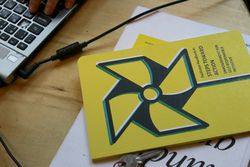From Competendo - Digital Toolbox
It may seem you have spent a lot of time doing other things before working on the “real content,” but all those steps are necessary elements that enable you and your participants to create a good learning experience. While working on the content, it is important to provide the participants with a lot of different learning opportunities and use a mixed style of methods.
Every participant learns in a different way and we have to give everybody the possibility to learn as much as possible. At the same time, it is very important to stay authentic as a facilitator. If you do not feel comfortable with a method, then it’s better not to use it. Working on content in a holistic way means not only addressing different learning preferences but also creating learning experiences that are close to real life. The following approaches and methods support you in managing this kind of learner-centered learning process.
Moderation
Moderation means to shape a common learning or discussion process. A moderator offers methods and guides the process.
Presentation & Visual Facilitation
The section includes methods for vizualization and presentation.
Some hints for the preparation of a presentation
(Re)discover your natural ability to communicate and express yourself in a more visual way. Explore the potential of visual language and use it for a more comprehensive moderation of learning and group processes.
Present your ideas precisely and creatively with a projector. Pecha Kucha connects both goals within 6 minutes and 40 seconds.
The more possibilities for development you consider, the more likely it is for your idea to lose clarity. This method introduces the need for focus and for concentrating on a few aspects. We use wooden matchsticks.
Bullet journalling is a creative methodology how to structure notes and thoughts, and how to save thoughts and inspiration. It can be used by facilitators and participants, for example in learning journals or in note-keeping.
Collecting and structuring opinions, ideas, facts.
Training and reflecting discussion skills by using visual impulses.
Energizers & Cool-Downs
Energizers and cool-downs help learners to refocus attention, to return to the learning process, and to reconnect to the group.
Energizers and cool-downs have the function to help learners refocus their attention, to return to the learning process, and to embed themselves (again) in the group. These tasks contribute to a methodological balance and variation.
Energizers and cool-downs have the function to help learners to refocus their attention, to return to the learning process, or to embedd themselves (again) in the group. These tasks contribute to a methodological balance and variation.
Big group methods
Approaches for facilitating processes with bigger groups of participants.
Moderation of large groups that delegates a great amount of responsibility to the participants. They suggest contents, decide about them, and are responsible for their realisation and the documentation of learning outcomes.
A method for learning and exchanging ideas on a broad bandwith of topics. Participants go around and visit different tables which are each dedicated to one topic or key question.
A proposal for an idea-development workshop with larger groups of people who want to implement a civil initiative.
Navigation:
 During
During
Check Out Our Handbooks

The handbooks for facilitators contain the best of Competendo. Download and read them here: more








